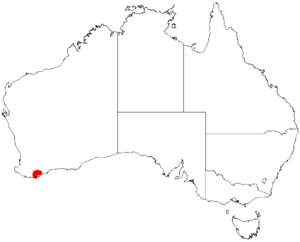Darwinia leiostyla facts for kids
Quick facts for kids Darwinia leiostyla |
|
|---|---|
 |
|
| In the Stirling Range. | |
| Conservation status | |
| Scientific classification | |
| Genus: |
Darwinia
|
| Species: |
leiostyla
|
 |
|
| Occurrence data from AVH | |
| Synonyms | |
|
|
Darwinia leiostyla is a special type of shrub. It belongs to the Myrtaceae family, which includes plants like eucalyptus. This plant grows upright and is found only in the southwest part of Western Australia. This means it is endemic to that area.
It usually grows to be about 0.3 to 1.5 meters tall. That's roughly the height of a small person! Its branches are covered with thin, straight leaves. These leaves can be up to 10 millimeters long.
From May to January, you can see its unique flowers. They hang down and look like bells. These aren't single flowers. Instead, they are clusters of small flowers. These clusters are surrounded by larger, colorful parts called bracts. These bracts can be pink, red, or white. They look like petals.
About the Name
This plant was first officially described in 1852. A scientist named Nikolai Turczaninow gave it the name Genetyllis leiostyla. He published his findings in a science bulletin.
Later, in 1923, another scientist named Karel Domin changed its name. He renamed it Darwinia leiostyla. The second part of its name, leiostyla, has a special meaning. It comes from Greek words and means "having a smooth style". The style is a part of the flower.
Where It Grows
Darwinia leiostyla is found in specific places in Western Australia. You can see it in the Stirling Range and around Middle Mount Barren.
It likes to grow in rocky areas. You might also find it along small streams or on slopes. It prefers to live inside gullies and mountain ranges.
How It's Protected
The Government of Western Australia's Department of Parks and Wildlife keeps track of this plant. They have given Darwinia leiostyla a special classification. It is called "Priority Four".
This means the plant is rare or nearly threatened. It is important to protect it so it doesn't disappear.
Growing This Plant
Sometimes, people grow this darwinia plant in their gardens. It is used as an ornamental plant because it looks beautiful.
If you want to grow it, it needs a warm and dry spot. You also need to trim its tips regularly. This helps the plant keep its nice shape. It can be grown in pots or in rock gardens.
Images for kids



